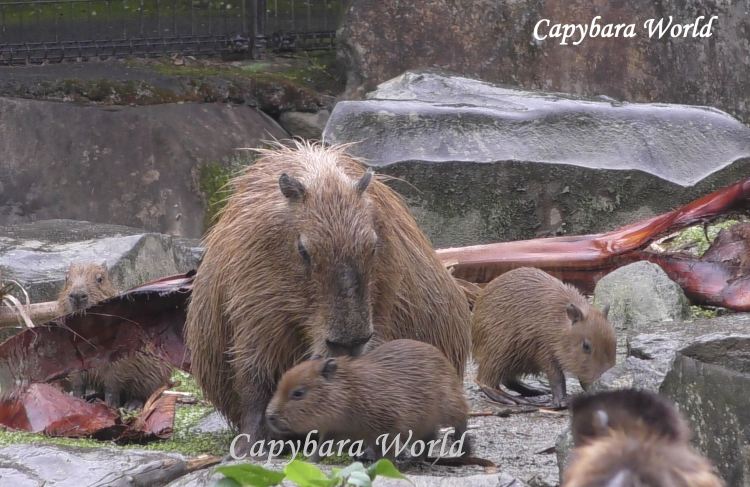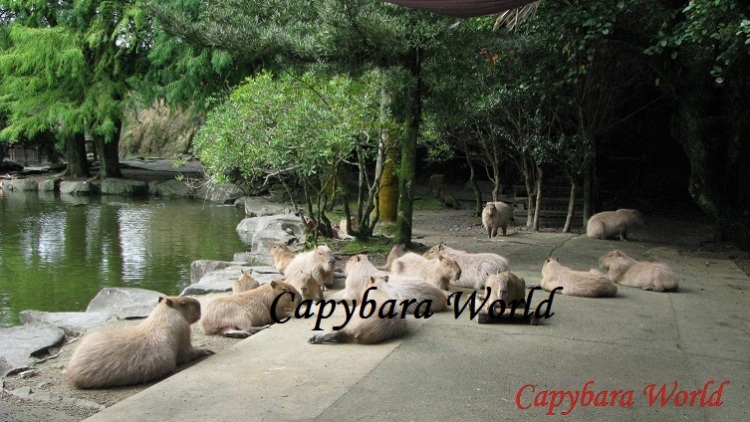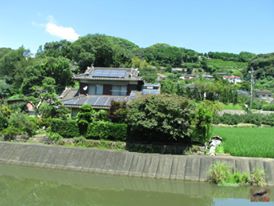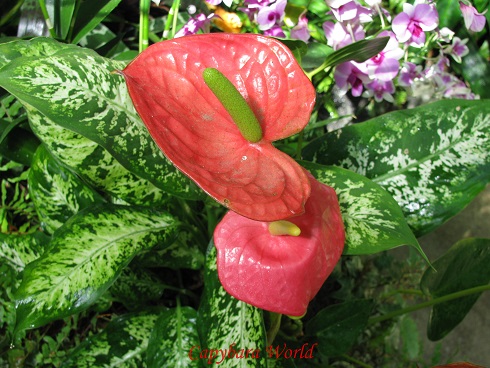I am afraid I have had to remove the photos as some nasty person has been removing the watermark from my photos and uploading them to the internet. It is illegal to remove the watermark.
These are the cutest baby capybaras ever!

The View from the Top of the Hill Just before You Enter the Capybara Enclosure.
To see the Enchanting Capybaras. Of course there are lots of other Animals, many of which you can pet, and Botanical Gardens.
Having a capybara come over to you and sit affectionately in your lap is the most wonderful experience. Many of the capybaras at Nagasaki Bio Park will sit on the laps of visitors these days.
https://www.youtube.com/watch?v=fdNE6omkqvM
Visiting Nagasaki Bio Park is very easy to achieve. The Bio Park is set in an area of outstanding natural beauty, The Saikai National Park with over 400 small islands (the Kujukushima Islands and the Gotō Islands). Hiring a car is expensive, but with GPS you could easily spend a day or two driving around around this scenic area. Road signs and route numbers are in English.
I would avoid major holidays like Golden Week which runs from about April 29th through May 6th. This link gives holidays in Japan for 2015:
http://portalseven.com/calendar/Holidays_Japan.jsp?year=2015#page=divHolidayListTab
Nagasaki is an attractive city, with European architectural features from its past as one of the few places in Japan that allowed foreigners to settle.
http://en.wikipedia.org/wiki/Nagasaki

Baby Aoba loves to sleep on top of her mother Momiji. Momiji is a fantastic mother. おめでとう!リトル青葉はミイラもみじの上で寝大好き。もみじは素晴らしい母親であります
Brief History of Japan’s Period of Seclusion:
From 1641 to 1853, the Tokugawa shogunate of Japan enforced a policy which it called kaikin. The policy prohibited foreign contact with most outside countries. However, the commonly held idea that Japan was entirely closed is misleading. In fact, Japan maintained limited-scale trade and diplomatic relations with China, Korea , the Ryukuyu Islands and the Netherlands”
.
Sakoku—seclusion from the outside world. During the early part of the 17th century, the shogunate suspected that foreign traders and missionaries were actually forerunners of a military conquest by European powers. Christianity had spread in Japan, especially among peasants, and the shogunate suspected the loyalty of Christian peasants towards their daimyō, severely persecuting them. This led to a revolt by persecuted peasants and Christians in 1637 known as the Shimabara Rebellion which saw 30,000 Christians, rōnin, and peasants facing a massive samurai army of more than 100,000 sent from Edo. The rebellion was crushed at a high cost to the shōgun’s army.
Missing photo: Hinase’s 4 babies spent several hours sleeping as close together as they could possibly be.
After the eradication of the rebels at Shimabara, the shogunate placed foreigners under progressively tighter restrictions. It monopolized foreign policy and expelled traders, missionaries, and foreigners with the exception of the Dutch and Chinese merchants who were restricted to the man-made island of Dejima in Nagasaki Bay and several small trading outposts outside the country. However, during this period of isolation (Sakoku) that began in 1635, Japan was much less cut off from the rest of the world than is commonly assumed, and some acquisition of western knowledge occurred under the Rangaku system. Russian encroachments from the north led the shogunate to extend direct rule to Hokkaidō, Sakhalin and the Kuriles in 1807, but the policy of exclusion continued.
The end of this period of seclusion was signalled by the arrival of Commodore Perry on July 8, 1853, Commodore Matthew Perry of the United States Navy with four warships, the Mississippi, Plymouth, Saratoga, and Susquehanna, which steamed into Yokohama bay. He requested that Japan open to trade with the West. These ships became known as the kurofune, the Black Ships.
During this period of isolation the culture of Japan developed with limited influence from the outside world. Japan had one of the longest stretches of peace in history. It developed thriving cities and castle towns and increased commodification of agriculture and domestic trade. This, together with increasing literacy and the concomitant print culture, laid the foundations for modernization, even as the shogunate itself grew weak.

Donut looks after Zabon’s babies just 10 days old
As a foreigner, you will find most people will go out of their way to be friendly and helpful; they want you to have a good impression of their country. You will be surprised how little English is spoken. My Japanese friends tell me this is because English lessons at school concentrate on written English, so many people may be able to read and write a little English, but fewer will speak it.
It’s worth checking TripAdvisor to get information and other people’s opinions on planned accommodation, etc.
Missing photo: Yasushi, who has longer hair then many capybaras, responds to being petted by “pilo-erection” – his hair rises in response to the pleasurable stimulus.
TRANSPORT
There are Information Desks, with English speaking staff, at all the main airports (including Nagasaki), and main Bus and Rail stations, including Sasebo.
Most international flights arrive at Tokyo’s Narita Airport. British Airways flies to both Haneda Airport, which is closer to Tokyo and from which most domestic flights go, as well as Narita. From Narita there is a straight forward connection to Tokyo Haneda Airport. There is a Limousine Bus which costs 3000 Yen per adult, and takes between 65 – 85 minutes depending on traffic. There is also a rail link; depending on the time of day, you may have to change trains. Ask at the Information Desk for details. For the latest transport information regarding travel into Tokyo, and between Narita and Haneda Airports, go to this site:
http://www.narita-airport.jp/en/access/haneda/index.html
British Airways has daily flights between London-Heathrow (LHR) and Haneda airport.
You can fly from Haneda to either Nagasaki or Fukuoka. Nagasaki airport is more convenient for getting to the Bio Park, but there are more flights between Haneda and Fukuoka.
Domestic flights to Nagasaki go from Haneda Airport, Tokyo’s other main Airport. There are flights throughout the day. At the time of writing:
JAL has 6 flights a day. This is their website:
ANA has 8 flights a day, 4 of which are operated by its partner airline, Solaseed. This is their website:
http://www.ana.co.jp/asw/index.jsp?type=de
The cheapest option is with Skymark, a low cost carrier. Many of their pilots are Westerners. http://www.skymark.co.jp/en/
Nagasaki Airport Website has information on how to get to and from the airport: including to Huis Ten Bosch , Nagasaki and Sasebo:
http://www.nabic.co.jp/english/access/index_kotsu.html
You can also fly from Tokyo Haneda airport to Fukuoka airport; Fukuoka is the main city on the island of Kyushu and there are more flights from Haneda to Fukuoka, than from Haneda to Nagasaki. The journey from Fukuoka airport to Huis ten Bosch is longer and costs more, than from Nagasaki airport to Huis ten Bosch. You will have to take the underground/subway called “chikatetsu” in Japanese, from Fukuoka airport to Hakata station. Then you will need to take the train from Hakata station to Huis ten Bosch; the journey time is 1 hour 50 minutes if you catch the direct train, otherwise you will need to change trains.
Missing photo: Capybaras Resting on Capuchin island
The best place to stay is Huis Ten Bosch, (Huis is pronounced “Haus” in Japan). There are a number of luxury (4 and 5 star) hotels here including the Lorelai (from which the Bio Park bus goes) which often has the best rates, the Nikko Hotel, and the Okura Hotel. Holders of a Bio Park pass receive a 20% discount at The Lorelai. The hotels run a free shuttle bus service to the central bus station, which is by the Okura Hotel.
Hotel Lorelei: http://www.lorelei.co.jp/index.html
The Okura Hotel is a re-creation of the historic Amsterdam Central Railway Station. You can’t miss it! http://www.okura.com/hotels/huistenbosch/index.html
I recommend the Lorelei Hotel. I injured my foot badly and we had to extend our stay by 3 months while it healed. The hotel was incredibly helpful spending over an hour trying to find us an English-speaking doctor (in fact it turns out many of the doctors speak English) and later contacting the Immigration Office in Nagasaki as we had to extend our visa. Everyone working at the Lorelei Hotel was exceptionally helpful and one staff member gave us a huge bag of tangerines, which are in season in Kyushu at this time of year.
If you get a Bio Park Annual Pass you will get a 20% discount on room rates at The Lorelai Hotel.
If you are looking for budget accommodation there are hostels, including one run by the Catholic Church, in Nagasaki. There is a public bus, bus number 20, which runs between the central bus station in Nagasaki and The Bio Park. The fare in 2014 was 780 yen one way. Journey time is approximately one and a half hours.
The Bio Park runs a free bus service from 2 points in Huis Ten Bosch to the Bio Park. These are: 1) From outside the Lorelai Hotel and 2) from the Bus Station outside the Okura Hotel. The journey from Huis Ten Bosch to The Bio Park takes about 45 minutes through sometimes stunning countryside and seascapes. The bus schedule is available from their website: BioPark access – http://www.biopark.co.jp/en/access/.
The easiest way to get to Huis Ten Bosch from Nagasaki Airport is by bus. Buses run at frequent intervals. The Information Desk at Nagasaki Airport will give you all the information you need, including bus timetables, fares etc.
Information about the Japanese Railways (JR) Pass and the Timetable can be found at this website. It is hosted by a Japanese gentleman who is only too happy to answer in English your questions about the rail system: http://jprail.com/travel-informations/fare-calculation.html
Japanese Railways have an excellent timetable at this site: http://www.hyperdia.com/en/
The nearest railway station to Nagasaki BioPark is Huis Ten Bosch.

Capybaras sleeping waiting for breakfast. 長崎バイオパークで眠るカピバラ。ミドル、リアビューでどんぐり
BUS
There is a bus from Nagasaki Airport to Huis Ten Bosch Bus Station which is in front of the Okura hotel. From here there are free shuttle buses to other hotels in Huis Ten Bosch
There is also a free shuttle bus from Huis Ten Bosch Bus Station to the Bio Park (see above and below).
By bus from Nagasaki city to Nagasaki Bio Park:
To get to Nagasaki Bio Park from Nagasaki City go to Shinchi bus station (there are several bus stations in Nagasaki so be sure to go to this bus station). Then take a number 1 bus (see next paragraph). There are about 7 buses a day. The Bio Park is open from 10 AM to 5 PM. Not every bus makes the short detour from Futamata, also called Stamata, to Nagasaki Bio Park: 1 in the morning arrives at approximately opening time at the Bio Park, and one late afternoon which leaves the Bio Park at approximately 16. 50 p.m. (I would be there for 16. 45 p.m.). Otherwise you get off at Futamata, which is a very short 5 minute walk from the Bio Park. The Biopark is clearly signposted at the traffic lights at Futamata. When you get off the bus at Futamata, cross the road at the traffic lights, and continue across the first bridge. Then turn right and cross a second bridge. You will see the entrance to the Bio Park car park to your left. Futamata is tiny.
Please note: not every number 1 bus goes to Futamata. You can get a bus timetable in English from the Information Office at Nagasaki train station (not Nagasaki bus station!) if you happen to be going to Nagasaki train station. At Shinchi bus station ask at the information kiosk which platform the bus to Futamata or Nagasaki Bio Park goes from – not every number 1 bus goes to Futamata/Nagasaki Bio Park. The journey time by bus from Nagasaki Shinchi bus station to Futamata/Nagasaki Bio Park is approximately 1 and half hours if you take the direct bus. It’s a very beautiful drive for much of the way. You should allow plenty of time to find your way around the bus station and connect with your bus. Make sure you have plenty of change. The bus fare in 2018 was approximately 1,100 yen. Board the bus at the door in the middle of the bus, and take a ticket. You pay on reaching your destination when you exit at the front of the bus beside the driver.
The bus back from the Bio Park is the number 20. You can catch this bus at the Bio Park; it leaves at approximately 16. 50 p.m. (bus times do change from year to year so check the times. The Bio Park can give you an up-to-date timetable for the journey from Nagasaki Bio Park back to Nagasaki city). You can also catch bus number 20 from outside the supermarket at the red sign. There are many more buses from here, at the supermarket in Futamata, to Nagasaki city than from the Bio Park.
If you are planning to travel round Kyushu, there is more information about Long Distance Bus Routes in Kyushu at this site: http://www.rakubus.jp/english/
| Tips |
| * When you get on the bus, greet the driver by saying “Onegai shimasu.” Then, thank the driver by saying “Arigatou gozaimashita” when getting off the bus. |
ACCOMMODATION
The best place to stay is Huis Ten Bosch, (Huis is pronounced “Haus” in Japan). There are a number of luxury (4 and 5 star) hotels here including the Lorelai (from which the Bio Park bus goes) which often has the best rates, the Nikko Hotel, and the Okura Hotel. Holders of a Bio Park pass receive a 20% discount at The Lorelai. The hotels run a free shuttle bus service to the central bus station, which is by the Okura Hotel.
Hotel Lorelei: http://www.lorelei.co.jp/index.html
The Okura Hotel is a re-creation of the historic Amsterdam Central Railway Station. You can’t miss it! http://www.okura.com/hotels/huistenbosch/index.html
I recommend the Lorelei Hotel. I injured my foot badly and we had to extend our stay by 3 months while it healed. The hotel was incredibly helpful spending over an hour trying to find us an English-speaking doctor (in fact it turns out many of the doctors speak English) and later contacting the Immigration Office in Nagasaki as we had to extend our visa. Everyone working at the Lorelei Hotel was exceptionally helpful and one staff member gave us a huge bag of tangerines, which are in season in Kyushu at this time of year.
If you get a Bio Park Annual Pass you will get a 20% discount on room rates at The Lorelai Hotel.
If you are looking for budget accommodation there are hostels, including one run by the Catholic Church, in Nagasaki.
Where to Eat in Huis Ten Bosch:
Lorelei Hotel Restaurant. I would recommend the restaurant at the Lorelei Hotel which serves both Japanese and Western food. The hotel restaurant has an excellent buffet with an extensive choice of dishes, both Japanese and Western. It is excellent value.
Huis Ten Bosch is the setting for a theme park in Nagasaki Prefecture which features many buildings built in the traditional architectural style of the Netherlands. There are hotels, museums, shops and restaurants, canals and windmills. Huis Ten Bosch itself may not be of great interest to Westerners, other than for its convenient location with accommodation and transport connections to The Nagasaki Bio Park. It is named after Huis Ten Bosch one of the three official residences of the Dutch Royal Family located in The Hague, in the Netherlands.
http://en.wikipedia.org/wiki/Huis_Ten_Bosch_(theme_park)
Here is an entertaining video of the Tapirs cavorting in their pond during a thunderstorm:
http://www.youtube.com/watch?v=oDOeN-mxYDY
The Hashimoto Hotel, is only a 10 mins drive from the Bio Park, near the coast in a beautiful area. However, I have not found an English language website to book this. Tel: +81-959-28-0011 Location on Google maps: https://maps.google.com/maps?f=q&hl=en&q=33.00143,129.730157&z=13
There is also a Minshuku (like a B&B but with dinner as well. Yoshino (guesthouse) Tel: +81-959-27-1200 Location on Google maps: https://maps.google.com/maps?f=q&hl=en&q=32.994989,129.754345&z=13
A cheaper option is to stay in Sasebo (which has an American Military Base) at the Toyoko Inn right by the train station. However this increases your daily travelling time by at least one and a half hours, and is only worth considering if you are planning to visit the Bio Park for many, many days! (We visited every day for a month, I found observing the capybaras social interactions fascinating, and of course I loved petting them). For most people Huis Ten Bosch or Nagasaki are the best places to stay . If you do stay in Sasebo you can buy a monthly rail pass, we organised this at the ticket office at Sasebo Station, where English is s spoken.
If you are looking for budget accommodation there are hostels, including one run by the Catholic Church, in Nagasaki. There is a public bus which runs between the central bus station in Nagasaki and The Bio Park.

Flamingos at Nagasaki Bio Park
We spent our first 3 nights at The Chisun Inn near Nagasaki airport, while we got onto local time, as it is much cheaper than Huis Ten Bosch. The hotel is actually in Omura and we had lovely views over beautiful Omura Bay. Rooms can be small in non-luxury hotels. There is a large supermarket just across the road. (You can sometimes get reduced sushi at about 6 pm!) There is no public transport to the Chisun Inn, but it is a short 10 minute taxi ride, costing 1300 Yen. 3 men helped organise our taxi and lift our 4 heavy bags. The Japanese tend to travel very light, so we felt quite conspicuous with our excessive baggage. The Chisun Inn is part of the Solare Hotels Group.
http://www.solarehotels.com/english/
Accommodation in Japan can be expensive. If you are travelling around Japan the 2* Toyoko Inn chain, is good value. The hotels are usually very close to train stations, though no less attractive for that. Rooms are small by western standards. Some of the hotels have very thin walls. We always travel with a Marpac ‘white noise’ machine, so for us noise was not such a problem. There is a Toyoko Inn near Haneda (2 actually side by side) which is probably the best value place to stay near the airport. The staff at the hotels we stayed in spoke some English. In Sasebo (at the Toyoko Inn) we had tasty, free Japanese breakfasts and free wifi. http://www.toyoko-inn.com/eng/

A Wallaby at Nagasaki Bio Park. I was surprised how soft their fur is. You can mingle in their enclosure and pet them
Nagasaki Bio Park
Information on how to get to the Bio Park from a number of locations including Nagasaki and Fukuoka, by bus, train or car can be found at the Bio Park website:
BioPark access: http://www.biopark.co.jp/en/access/
This site includes information and the timetable for the free Bio Park Shuttle Bus from/to Huis Ten Bosch.
The Bio Park runs a free bus service from 2 points in Huis Ten Bosch to the Bio Park. These are: 1) From outside the Lorelai Hotel and 2) from the Bus Station outside the Okura Hotel. The journey from Huis Ten Bosch to The Bio Park takes about 45 minutes through sometimes stunning countryside and seascapes.
Reservations should be made using the email address listed, or by telephone. When we visited in August the bus was rarely full. I had the impression people only booked up a few days in advance if that. You might well be able to make a last minute reservation except at holiday times. Weekends are busiest, with Sunday being the busiest day. Weekdays are much nicer; you might well get the capybaras all to yourself!

This is the countryside at the entrance to Nagasaki Bio Park with this beautiful Japanese house. I wonder who lives there, just a few minutes walk from the Capybaras? The photo doesn’t do justice to how pretty and rural the area is.
If you would like More Information about Visiting The Nagasaki Bio Park, go to my blog:
Here is a blog I have written about the capybaras at Nagasaki Bio Park. Like humans they are all individuals and have different personalities. And of course like humans you can recognise them by their faces – they all look different. Visiting them is so much more interesting when you know who they are
すべての動物は、個々のです。ちょうど人間のように。喜びははるかに大きいです。カピバラの名前を知っています。カピバラのキャラクターと個性を知ってい ます。あなたははるかにカピバラをお楽しみいただけます。あなたは彼の名前を知らない場合はカピバラを侮辱です。彼の性格。カピバラを認識してください。 彼らはこれを値しま:
Use of Credit Cards
Most ATM’s do not accept foreign credit cards. Nagasaki Airport has one ATM which does. Haneda International Terminal (but not the Domestic Terminal) and Narita also have ATM’s which accept foreign credit cards.
Some taxis in major towns do take credit cards, but usually only domestic ones; these tend to have a sign on the rear left passenger door. Whenever we tried to use a foreign credit card for a taxi it was not accepted. You can always try though. Smaller businesses, super markets, restaurants, etc. in rural areas accept cash only. Indeed most of Japan is still cash only outside of the large towns and cities. You will always need to be prepared to be able to settle in cash. The exceptions are major hotel chains, rail pass, the gift shop at the Bio Park, and similar.
Another tip is that most large Post Offices have an international ATM in them with English instructions.
WiFi
McDonalds have free wifi if you get desperate. There is also free wifi at Haneda Airport, depending where you sit.
Video Links:
There is nothing as magical as 14 Capybara singing (eeping) in unison. This chorus goes on for up to half an hour or longer. I’ve tried to capture some of this magic in this short video. One person who has seen the video said “This sounds make me happier!” : https://www.youtube.com/watch?v=4Z6o5DC3–A
If you want to see what a blissfully happy Capybara looks like when he is being petted, these 2 give an idea of how enjoyable petting a capybara is:
https://www.youtube.com/watch?v=z9EHV-AvQyc
https://www.youtube.com/watch?v=pSvVHmoUHDQ
A couple of videos showing just how playful, and amusing to watch ,Capybaras can be: (In the first video most of the action happens after about 1 min. 8 secs)
https://www.youtube.com/watch?v=Id_pgMOib-Y
https://www.youtube.com/watch?v=szuhRSV6zMI
If you would like to see more Videos about Capybaras, go to Capybara World on Youtube:
http://www.youtube.com/user/rangdaaaa?feature=results_main
//
//
//
//
//
//
//
//
//
//
//
//
//
//
//
//


Great amount of information! I am planning to visit the NBP in the future. Thank you
(^t ^ \
LikeLike
Thanks. Fujiko has just had 2 babies (14th Sept). They are really cute. BTW you saw my other post about the Bio Park? I’ll be writing about some of the capybaras over the next few months!
LikeLike
Yes, I read your previous and all of the following posts here. I’m looking forward to read more of them in the future. So, how many capybaras live now at the Nagasaki bio park? Including the babies of course
LikeLike
Try again! At the moment, incl babies, there are 15 capybaras in the ‘petting’ enclosure. Plus 2 males in separate enclosures. Toku, who was going to replace Yasushi eventually as breeding male, but they think he is too nervous. And Ran, who came from Holland, to replace Yasushi some time in the future. He is in a tiny pen on his own, with a completely inadequate water supply. Capybara are intelligent and he has nothing to play with. He always looks unhappy and frightened. I have tried to find out why they keep him like this. And I’m wondering if I could ever persuade them to move him.
In August there were 2 others in the petting enclosure. Kobuko, who very sadly died. She was very old, 12 or 13, but should not have died. And Nina a young male who injured his eye and was taken away for treatment. He will not go back to the herd as males tend to fight as they get older. I am waiting to find where he will go.
If the babies are female I think they will stay at Bio Park
LikeLike
btw I didn’t know the photo of Io-kun eating a watermelon was yours! It is famous – it was used at their official site, when they announced the live-streaming with capybaras. Great photo
LikeLike
It’s not mine. The Bio Park posted it on my FB wall. I asked them if I could use it
LikeLike
ah, but I like your other photos too 🙂 so nice from them to let you use this photo here
LikeLike
Try again! At the moment, incl babies, there are 15 capybaras in the ‘petting’ enclosure. Plus 2 males in separate enclosures. Toku, who was going to replace Yasushi eventually as breeding male, but they think he is 2 nervous. And Ran, who came from Holland, to replace Yasushi some time in the future. He is in a tiny pen on his own, with a completely inadequate water supply. Capybara are intelligent and he has nothing to play with. He always looks unhappy and frightened. I have tried to find out why they keep him like this. And I’m wondering if I could ever persuade them to move him.
In August there were 2 others in the petting enclosure. Kobuko, who very sadly died. She was very old, 12 or 13, but should not have died. And Nina a young male who injured his eye and was taken away for treatment. He will not go back to the herd as males tend to fight as they get older. I am waiting to find where he will go.
If the babies are female I think they will stay at Bio Park
LikeLike
Kasia, WordPress won’t let me reply to your comment posted 7th Oct, so here’s my reply.
At the moment incl babies there are 15 capybaras in the ‘petting’ enenclenclosure
LikeLike
Pingback: ליסינג פרטי מחירון
I’m sorry google translate does not make sense
LikeLike
Pingback: Visiting Nagasaki Bio Park was one of the Best Experiences of my Life; if you Love Capybaras it is an absolute ‘Must Visit’ before you die | capybaraworld
Hello.
Do you know how to get from Nagasaki Station? I think that there are direct bus, but I don’t know the bus number and either the timetable and fare.
Thank you.
LikeLike
There is a bus that runs, approximately every half hour, from Nagasaki bus station via Nagasaki train station to the Bio Park. 7 of the buses go direct to the Bio Park (Starting at Possibly about 8:30 AM. The last bus Back to Nagasaki leaves the Bio Park at About 16.54 PM).
The other buses stop at the traffic lights which is no more than a 10 minute walk from the entrance to the Bio Park.
I will try and find out the number of the bus.
The buses run from about 6.07 a.m. until 2015 PM. The journey time is about 1.30 hours.
There will be somebody at the Information Office at Nagasaki station who will speak some English and can give you the information you need about which bus goes to Nagasaki Bio Park and a timetable.
LikeLike
Great information for me. Thank you very much. Very kind.
LikeLike
I have been told that there is no number for the bus route from Nagasaki station to the Bio Park.
I imagine the first bus from Nagasaki station to the Bio Park leaves Nagasaki about 8 AM or even earlier.
I hope this helps and have a wonderful time at the Bio Park
LikeLike
Thank you. I haven’t been able to get the bus number yet, but I suspect the first bus from Nagasaki station to the Bio Park leaves about 8 AM or even earlier
LikeLike
Don’t worry. Thank you very much for your help.
LikeLike
Pingback: “What Are You Doing Strange Human” Capybara Wonders 何してるの奇妙な人間 “カピバラの驚異 | waaw